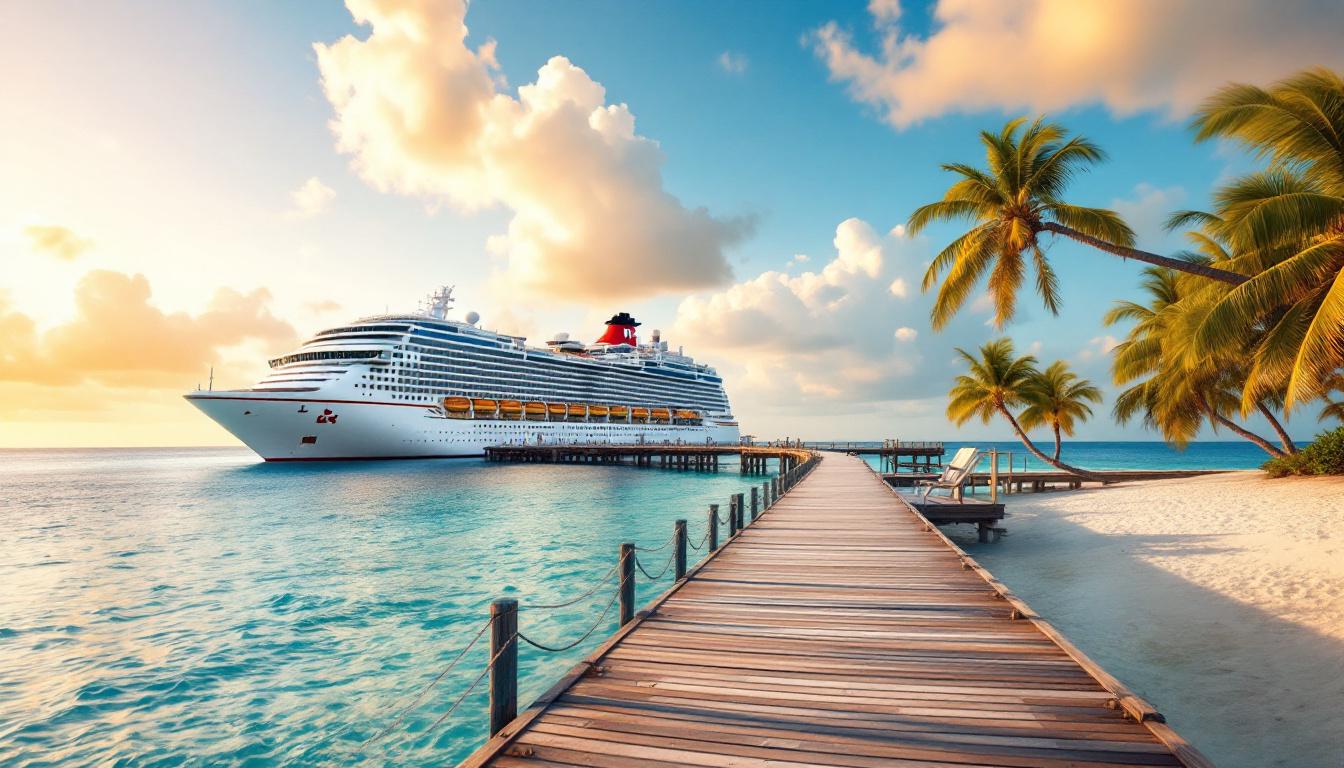Standing on my ship’s deck at dawn, I watched something impossible unfold. Instead of tender boats ferrying passengers to shore, our massive Disney cruise ship glided directly to a private pier. Castaway Cay remains the only private Caribbean island where cruise ships dock directly – a feat of engineering that transformed how we experience paradise.
After visiting dozens of cruise destinations, this moment still gives me chills. While other cruise lines force passengers into crowded tender boats for 20-30 minute transfers, Disney’s 1,000-acre sanctuary welcomes you with solid ground beneath your feet. The difference isn’t just convenience – it’s revolutionary.
What Disney guards so carefully is more than an island. It’s a 99-year commitment to perfection that began in 1997, when they transformed the forgotten Gorda Cay into the Caribbean’s most exclusive cruise destination.
The engineering marvel other cruise lines couldn’t replicate
Why direct docking changes everything
That first step off the ship onto Castaway Cay’s dedicated pier feels like magic. No waiting in tender lines, no seasick passengers, no weather delays that plague other private islands. Disney’s western-coast pier handles ships up to 340 meters – a technical achievement requiring deep-water access and precise positioning systems.
The operational advantage you’ll immediately notice
Forget lunch on crowded beaches at competitor islands. Here, you can walk back to your ship’s dining room in ten minutes. Need a nap? Your stateroom awaits just steps away. This seamless ship-to-shore connection lets you maximize both island adventures and onboard luxuries – something impossible at tender-dependent destinations like Royal Caribbean’s Perfect Day or Holland America’s Half Moon Cay.
The 55-acre paradise Disney keeps pristine
What most visitors never realize about the island’s scale
While competitors cram thousands onto small developed areas, Disney’s genius lies in restraint. Only 55 acres of the 1,000-acre island welcome guests – that’s barely 5% development. The remaining 945 acres stay untouched, creating a natural buffer that eliminates the crowded feeling plaguing other private islands.
The permanent community that makes it work
Unlike seasonal operations elsewhere, 150 Disney cast members live permanently on Castaway Cay. They’re the island’s heartbeat – maintaining pristine beaches, operating the desalination plant producing fresh water, and ensuring every detail meets Disney’s legendary standards. This year-round dedication creates consistency other cruise islands simply cannot match.
The Bahamian partnership that protects paradise
How Disney’s lease model differs from competitors
Disney’s lease running through 2096 with the Bahamian government created something unprecedented – long-term environmental stewardship rather than short-term profit extraction. While other cruise operators focus on maximizing visitor numbers, Disney’s contract prioritizes preservation, limiting daily guests and protecting marine ecosystems surrounding the island.
The cultural touches that honor Bahamian heritage
The island’s post office issues authentic Bahamian stamps with Disney themes – a small detail reflecting deeper cultural respect. Local Bahamian traditions appear in island activities, from conch shell demonstrations to traditional music performances. This cultural integration distinguishes Castaway Cay from sterile competitor destinations lacking authentic Caribbean soul.
Why competing cruise lines still can’t match this experience
The infrastructure investment that changed the industry
Castaway Cay’s pioneering pier required unprecedented deep-water engineering – extending into natural channels without damaging coral reefs. This $200+ million infrastructure investment established the gold standard, yet competitors still rely on tender systems because replicating Disney’s achievement requires massive capital and environmental expertise most cruise lines lack.
The exclusive access that creates true escape
Only one Disney ship visits daily, capping visitors at roughly 4,000 guests maximum. Compare this to public Caribbean beaches accommodating 15,000+ daily visitors, and you understand why Castaway Cay feels like a private resort. The adult-only Serenity Bay and family beaches never feel overcrowded – luxury impossible at multi-ship destinations.
Twenty-eight years after Disney’s revolutionary gamble, Castaway Cay remains unmatched. While cruise lines add tender-dependent islands yearly, none replicate the seamless ship-to-shore magic that makes this 55-acre slice of paradise the Caribbean’s most coveted cruise destination.
Experience the only place where your floating hotel literally connects to paradise. Book your Disney Caribbean cruise and discover why direct docking changes everything about island escapes.
Essential questions about Castaway Cay’s unique access
How does direct docking compare to tender boat systems?
Direct docking eliminates 30-45 minutes of tender transfers each way, weather delays, and passenger limits. You walk directly from ship to island in under 10 minutes, with unlimited back-and-forth access throughout your visit.
Can other cruise ships visit Castaway Cay?
No – Disney’s exclusive 99-year lease with the Bahamas restricts access to Disney Cruise Line vessels only. This exclusivity ensures controlled visitor numbers and maintains the island’s pristine condition.
What makes Castaway Cay’s facilities superior to other private islands?
The permanent 150-person staff, desalination plant, and year-round maintenance create resort-quality facilities. Unlike seasonal operations at competitor islands, Castaway Cay maintains Disney standards 365 days yearly.
How does Disney protect the island’s natural environment?
Only 5% of the 1,000-acre island is developed, with 945 acres remaining untouched natural habitat. The deep-water pier prevents reef damage from anchoring, while strict visitor limits minimize environmental impact.
Why haven’t other cruise lines built similar docking facilities?
The infrastructure investment exceeds $200 million, requiring deep-water engineering expertise and long-term government partnerships. Most cruise lines prefer lower-cost tender systems despite passenger inconvenience and weather limitations.
